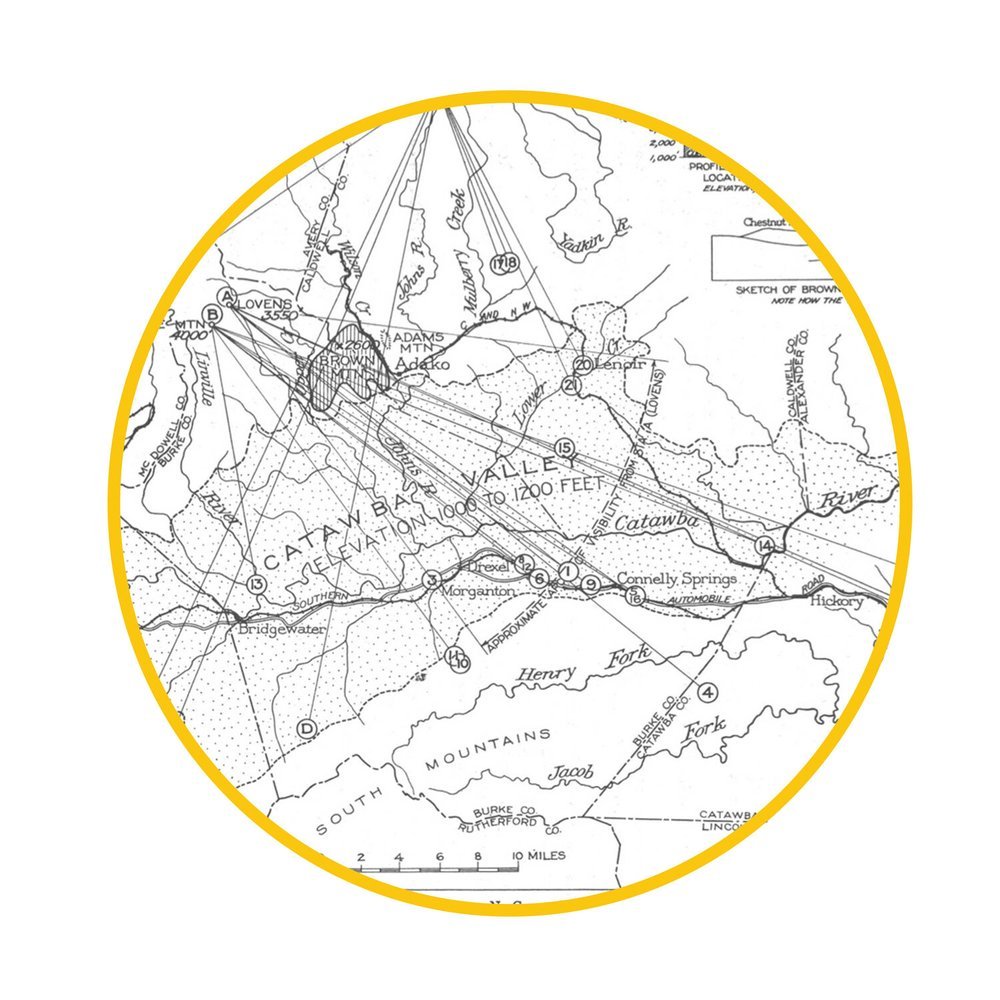Fact & Folklore: A Brief History of Burke County
FACT: First People
Around 15,000 years ago, the First People are believed to have crossed the Bering Land Bridge from Asia into what is now America. Later classified as Paleo-Indians, these First People are estimated to have migrated to what is now Burke County, North Carolina some 12,000 years ago. As members of what later became the Sioux, Iroquois, and Muskogee tribes, among the descendants of these First People are the modern Catawba, Cherokee, and Creek.
Passing their traditions and history down orally, the First People had no known written language. European explorers who arrived thousands of years later wrote histories of their expeditions and encounters with Indigenous people but did so through their own cultural lenses. With the eventual dislocation of many Native tribes, much of their oral tradition was lost. What is known about their societies has largely been determined through the study and interpretation of archeological sites and artifacts.
Deeper DiveInto First People
Burke County, NC
Image from the Museum of the Cherokee Indian in Cherokee, NC.
FACT: Spanish Conquest
In 1492, Italian explorer Christopher Columbus led a Spanish expedition in search of new trade routes in the Atlantic, paving the way for future expeditions. In the 1500s, after first earning a fortune in the Nicaraguan slave trade, Hernando de Soto became one of the most well-known Spanish Conquistadors. As part of Francisco Pizzaro’s expedition in 1532, de Soto also gained fame for his role in the conquest of the Inca of Peru.
Early exposure to Europeans began to devastate the cultures of Native tribes in South America and the Caribbean, and soon similarly affected North American Natives. Indigenous tribes in what would later become the United States of America encountered de Soto during Spain’s first exploration of the North American interior from 1540 to 1541. This expedition covered some 4000 miles, traversing what is now Georgia, the Carolinas, Tennessee, Mississippi, Arkansas, and Louisiana; heading for Mexico in search of silver, gold and further conquest.
Deeper Dive Into Spanish Conquest
FACT: Fort San Juan at Joara
The Native village called Joara, now also known as the Berry Archeological Site, was a large Catawba Indian settlement near present day Morganton. In 1566, just a quarter of a century after de Soto’s premiere exploration, Spanish explorer Juan Pardo halted his expedition from the Atlantic coast toward Mexico because of snow, and his soldiers built Fort San Juan at Joara. Thus was established the first European settlement in the interior of what is now the United States. The settlement lasted only 18 months.
Pardo left Fort San Juan in 1567, returning later that year on a second expedition that lasted until 1568 and planted five additional forts. After the second expedition to Fort San Juan ended, the short-lived European settlements were razed and burned by Natives, and all but one of the Spanish soldiers were killed. Fort San Juan pre-dated the English colony at Roanoke (the Lost Colony, 1585-1590) and the Jamestown Colony of Virginia (1607).
If Spanish colonization had been successful in North Carolina, America might be very different today.
Why was the fort destroyed? Was it too far inland? Was it too dependent on Native support? Did the Europeans consume too much food? Did they take liberties with Native women? Despite many theories no one knows exactly what happened, but the Spanish did not rebuild and gave up their attempts to colonize western NC.
Deeper Dive Into Joara
FACT: European Colonization
Interactions between Natives and Europeans were somewhat rare in the early days of English colonization because few whites were willing to endure the harsh conditions of the frontier. In the 1700s, this began to change as English, German, Scots-Irish, and French farmers started to migrate into Native territories.
With the population shift came unrest and war. Many Indigenous people fell victim to diseases introduced by European colonization, and others were dispossessed of their homelands and relocated to reservations across the county through the Federal Indian Removal Act of 1830.
When Burke County was officially established in 1777, it was a mammoth province consisting of parts of the following later established counties; Buncombe (1791), Yancey (1833), Caldwell (1841), Catawba (1842), McDowell (1842), Alexander (1847), Madison (1851), and Mitchell (1861). North Carolina, 12th of the original 13 states, was admitted into the Union in 1789.
Deeper Dive Into European Colonization:
Images from the Trail of Tears mural at the Museum of the Cherokee Indian in Cherokee, NC.
FACT TO FOLKLORE: The Brown Mountain Lights
There is an element of history that is passed down orally by all cultures. It interweaves with folklore to help us preserve particular stories of the past, to understand the nature of mankind, and to create cultural unity. Such stories are often passed down by word of mouth or in song, presenting the listener with cultural knowledge and particular ways of understanding their world. The Brown Mountain Lights exemplify this method of storytelling.
The presence of the phantom yellow lights on Brown Mountain has been recorded locally for hundreds of years, yet they show up sporadically and are described by observers in different ways. Some say they are stationary lights; others describe them as fast-moving blurs. Some say the lights appear suddenly and move erratically across the ridgeline, while others say they just appear and disappear. Sightings are the stuff of local legend with regional Indigenous tribes allegedly testifying of the lights as long ago as roughly the year 1200 A.D.
Images of Brown Mountain area and illustration of a Brown Mountain story.
“Where science has failed to explain the Brown Mountain Lights, local lore has continued to stir the curiosity of generations of observers. Many of the oldest legends are firmly positioned within regional beliefs and cultural assumptions of their times.”
—Leslie D. McKesson, Ed. D., Excerpt from The Brown Mountain Lights: Fact and Fiction, Logic and Lore
Most often visible around dusk from the Jonas Ridge overlook just north of Morganton, the Brown Mountain Lights are one of North Carolina’s oldest unexplained scientific phenomena. They spurred scientific inquiry at least as early as the late 1700’s with written records of sightings pre-dating the Revolutionary War. Numerous scientific speculations have attempted inconclusively to explain the presence of the lights, while local folklore offers cultural explanations. For example, some believe the lights are Indigenous women looking for their lost warriors. Others say the lights represent an enslaved man searching the mountain for his lost master. Still others say that the lights are settler women searching for a lost loved one or roaming the mountain as a result of their own deaths.
Whether you are interested in natural or paranormal explanations, or whether you’re intrigued by the cultural norms and nuances of times-gone-by as revealed through the folklore, the mysterious Brown Mountain Lights continue to cause us to ponder the breadth and depth of our human existence, and to reflect upon the unique history of the people of the North Carolina Blue Ridge Mountains.
Map of Brown Mountain region in North Carolina, illustrating origin of Brown Mountain lights in the Geological Survey Circular 646, by George Rogers Mansfield. United States Department of the Interior.
Sounds of Brown Mountain Lights
Scotty Wiseman’s famous song “Brown Mountain Lights,” has been performed by Sonny James, Roy Orbison, Tommy Faile, and Tony Rice, The Hillmen (Vern Gosdin – Vocals), Kingston Trio, Country Gentlemen, Acoustic Syndicate and by Yonder Mountain String Band. In this narrative, the light is being carried by a faithful old slave who has come back from the grave, searching for his lost master.
Lulu Belle and Scotty's rendition of The Brown Mountain Light. Issued on "The Sweethearts Of Country Music" and recorded circa June 1962. Arthur Smith Studio, 5457 Monroe Road, Charlotte, NC - Lulu Belle (vcl duet/gt), Scotty (banjo/vcl solo/vcl duet), Arthur Smith (gt). others unknown.
Acoustic Syndicate, Brown Mountain Lights, 1996. Acoustic Syndicate is a rock/folk/bluegrass band from North Carolina formed in 1992. They have toured nationally in the US, including appearances at Farm Aid and the Bonnaroo festival. Their sound is characterized by three-part vocal harmony and complex polyrhythmic banjo playing. Lyrically, the group often discusses themes relating to subsistence, sustainability and quality of life.
Tommy Faile. The Legend Of The Brown Mountain Lights. May, 1966. Composer: S. Wiseman. Producer: Arthur Smith.
Images of Brown Mountain Lights
Brown Mountain Bottleworks commissioned Marcus Thomas (the Urban Monk) to paint a two-story mural behind the downtown pub, based on the Brown Mountain Lights legend.
“...the lights symbolize the women’s lanterns looking for the lost souls. The silhouette with clouds is the lost warrior souls and the woman represents the women looking for them. The fish are symbolic of brown mountain trout, the only indigenous trout in the area."
—Muralist, Marcus "The Urban Monk" Interviewed for Strange Carolina, 2017
The Urban Monk’s two-story mural behind Brown Mountain Bottleworks.

